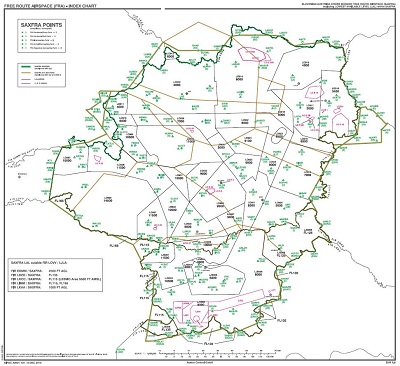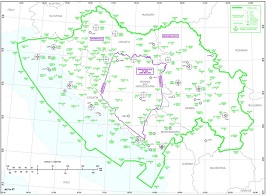Free route airspace (FRA) is a specified airspace within which users may freely plan a route between a defined entry point and a defined exit point, with the possibility to route via intermediate (published or unpublished) significant points, without reference to the ATS route network, subject to airspace availability. Within this airspace, flights remain subject to air traffic control.
Benefits
FRA is a way of overcoming the aviation sector's efficiency, capacity and environmental problems by helping to reduce fuel consumption and emissions, while improving flight efficiency. At the same time, it paves the way for further enhanced airspace design and ATM operational concepts.
With free route airspace projects now in place across more than three quarters of European airspace, the region’s flight efficiency targets are within grasp. Route extension - the difference between the flight flown and the corresponding portion of the great circle distance – due to airspace design went down from 3.58% in December 2007 to 2.00% in December 2021, thanks in part to initiatives like free route airspace and despite significant disruption in the network.
FRA is a key landmark in achieving free routeing across European airspace on the road to SESAR's business trajectories and 4D profiles. It will make it possible to meet the demands of future airspace users over the next 50 years, including civil and military unmanned aircraft systems (UASs), supersonic and hypersonic transport, spaceplane operations to sub-orbit and orbit, high altitude pseudo satellite (HAPS) platforms, plus balloons and airships.
Once fully implemented at European level, these improvements should allow the following savings, compared with the current situation:
- € 1 billion nautical miles
- € 6 million tonnes of fuel
- € 20 million fewer CO2 tonnes
- € 5 billion in fuel costs savings
FAB CE has set up a Project to synchronise the deployment of FRA in the FAB CE area to maximise user benefits:
Cross Border FRA Projects Overview and history:
Slovenian/Austrian Cross Border Free Route Airspace (SAXFRA)
In 2016 Austro Control and Slovenia Control successfully implemented Europe’s first cross-border Free Route Airspace procedure without any vertical or time-based restrictions.
SAXFRA offers airspace users the opportunity to fly between predefined entry and exit points using the most direct route possible. Airspace users are able to select the optimum route and vertical profile for their requirements via intermediate points. Enabling free route flying options in this complex and already highly-optimized environment offers an estimated savings of 13,000 kg of fuel daily and helps to reduce carbon dioxide (CO2) emissions by 43,000 kg per day.
South-East Axis Free Route Airspace (SEA FRA)
This was the first European FRA concept implemented over the territories of four States, two of which are members of FAB CE (Croatia and Bosnia & Herzegovina) with Serbia and Montenegro which are not a part of the FAB initiative, proving that such cooperation is possible and can be of benefit to all stakeholders. SEAFRA offers airspace users the opportunity to plan and execute flights 24 hours a day, seven days a week, free of fragmentation by State or AoR borders above FL325.
The idea of such a large-scale FRA programme was initiated by ATM experts of the ANSPs concerned, with a common goal of improving air traffic service safety, efficiency and environmental protection by reducing fuel burn, CO2 and nitrogen oxide (NOx) emissions.
South Eastern Europe Free Route Airspace (SEE FRA)

The completion of the SEE FRA project (South East Europe Free Route Airspace) on November 7, 2019 opened up 24/7 cross border free route operations across the airspace of Bulgaria, Hungary and Romania. At the beginning of 2021 Slovakia and in February 2023 the czech Republic joined the South East Europe Free Route Airspace (SEE FRA).
According to the simulations the synergistic effect of all improvements has the potential to save daily average up to 10,000 NM of the total mileage which represents 80 tons of fuel savings, 250 tons fewer CO2 emissions and 26 hours of flying time saved on a busy day.
SECSI FRA (South East Common Sky Initiative Free Route Airspace)
On February 1, 2018 SECSI FRA began operations, merging the two Free Route Airspaces SAXFRA and SEAFRA and offering airspace users significant benefits along the South East Axis, by delivering the shortest route options from Central Europe to South Eastern Europe. The benefits gained through the SECSI FRA are substantial. Based on the shortest route assignment potential savings per day are up to 1.940 NM in flight distance, 285 minutes in flight time, a reduction in fuel consumption of 8,000 kg and a reduction in CO2 emissions of 25,500kg.
SECSI FRA is expected to deliver potential savings of 600.000-700.000 NM in flight distance per year. It will make more options available when determining the user-preferred trajectory. Full cross-border FRA allows airlines to take better advantage of wind or adapt to network disruptions. The better use of FRA options at flight planning level improve predictability and reduce ATC workload.
In December 2021 SECSI FRA was expanded to include the airspaces of Albania and Northern Macedonia.
Outlook
There are two main FRA projects in the pipeline: the planned cross border operations between BALTIC FRA and FRACZECH as of February 2024 and the common initiative of FRAIT and SECSIFRA to operate cross-border, now revised to March 2024


